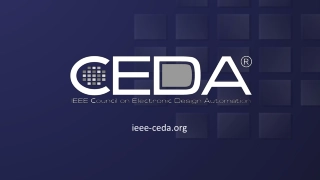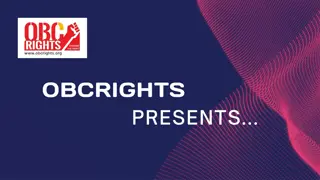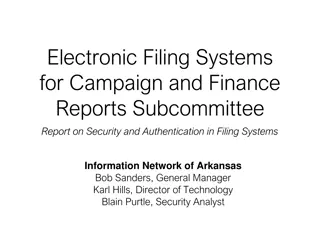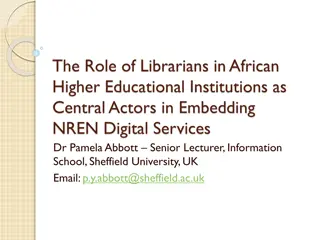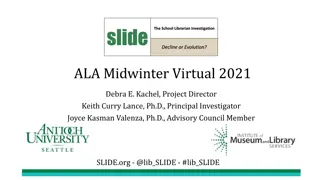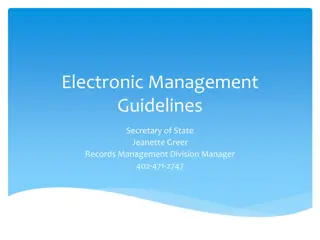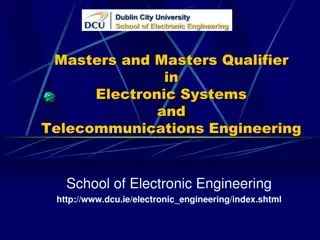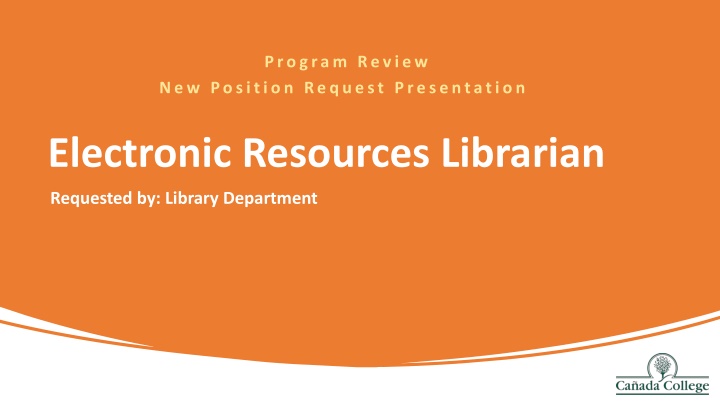
Leveraging Electronic Resources for Equity in Education
This presentation outlines the importance of an Electronic Resources Librarian role in enhancing accessibility to library collections, integrating technology for student success, and supporting equity in education through digital resource management. By aligning with strategic plans for student support and free community college initiatives, the request aims to close the equity gap by providing OER and free resources to students, easing financial burdens, and fostering success for all learners.
Download Presentation

Please find below an Image/Link to download the presentation.
The content on the website is provided AS IS for your information and personal use only. It may not be sold, licensed, or shared on other websites without obtaining consent from the author. If you encounter any issues during the download, it is possible that the publisher has removed the file from their server.
You are allowed to download the files provided on this website for personal or commercial use, subject to the condition that they are used lawfully. All files are the property of their respective owners.
The content on the website is provided AS IS for your information and personal use only. It may not be sold, licensed, or shared on other websites without obtaining consent from the author.
E N D
Presentation Transcript
Program Review New Position Request Presentation Electronic Resources Librarian Requested by: Library Department
1. Controlled Digital Lending Program: Establish, maintain, and manage a Controlled Digital Lending program, enhancing accessibility to library collections and adapting to the evolving academic resource landscape, ensuring students have access to the latest materials. 2. Technology Integration and Leadership: Utilize emerging technologies, including AI, to heighten awareness of library services. Provide ethical guidance on technology use, working closely with faculty to explore innovative applications that support instruction and improve student learning experiences. Electronic Resource Librarian 3. Digital Resource Management: Oversee the implementation, maintenance, and delivery of digital resources (databases, eBooks, streaming media). Customize interfaces, manage subscriptions, and address technical issues for a seamless user experience, collaborating with District teams and database providers. 4. Integration of Web-Based Library Products: Lead the integration of web-based library products into our website, including OneSearch and virtual reference tools. Continuously evaluate resources through usability testing and analytics to ensure equitable access and support College goals. In summary, funding the Electronic Resources Librarian is an investment in the College's commitment to continuous innovation, excellence in teaching and learning, and removing barriers to student access, success, and completion benefiting historically underserved students such as Hispanic, Black and AANAPISI.
Controlled Digital Lending Controlled Digital Lending (CDL) is the digital equivalent of traditional library lending. A library can digitize a book it owns and lend out a secured digital version to one user at a time, in place of the physical item. CDL has three core principles: A library must own a legal copy of the physical book, by purchase or gift. The library must maintain an owned to loaned ratio, simultaneously lending no more copies than it legally owns. The library must use technical measures to ensure that the digital file cannot be copied or redistributed. From: https://controlleddigitallending.org/faq
How does this resource request support closing the equity How does this resource request support closing the equity gap? gap? Directly closes the equity gap by providing OER and free library resources to students. Aligns with Ca ada's institutional responsibility to support equity in education. Contributes to Pillar Two of Guided Pathways, "Enter the Path." Eases the financial burden for students, making it easier for them to afford college, including textbooks.
Board of Trustees/Districts strategic Board of Trustees/District s strategic plans/recommendations, goals, or initiatives plans/recommendations, goals, or initiatives FREE COMMUNITY COLLEGE (SB 893)- SUPPORTS STUDENT BASIC NEEDS WITH TEXTBOOKS & MATERIALS AND TECHNOLOGY. CONTINUALLY EXPLORE AND IMPLEMENT INTERVENTIONS THAT BENEFIT ALL STUDENTS, WITH PARTICULAR EMPHASIS ON STUDENTS WITH HIGH POTENTIAL AND LIMITED RESOURCES. MEASURE THE IMPACT OF NEW AND EXISTING COLLEGE EFFORTS TO INCREASE SUCCESS AND EQUITY FOR ALL STUDENTS. CLOSE GAPS THAT RESULT IN INEQUITABLE OUTCOMES. SUPPORT THE COLLEGES BY PROVIDING RESOURCES FOR TEACHING AND SUPPORT INNOVATIONS THAT ARE DESIGNED TO INCREASE STUDENT SUCCESS.
Contribute to the financial stability of students by leading the Library department in OER/ZTC initiatives. Collaborate with the OER/ZTC Faculty Coordinator to assist faculty in seamlessly transitioning their courses to ZTC, fostering a collaborative environment for academic innovation. College Goal: Student Access, Success and Completion Currently facing a deficiency in expertise, the Electronic Resources Librarian role is critical to bridge the knowledge gap and meet the increasing demands for OER/ZTC support. Alleviate existing staffing pressures by dedicatedly managing the expanding OER/ZTC initiatives, ensuring a more streamlined and efficient support system for faculty and students alike. Spearhead the Controlled Digital Lending and Electronic Reserves program at the Library, ensuring cutting-edge digital access to educational materials for both online and in-person learners. Lead the Library in introducing services aimed at dismantling barriers, fostering a more equitable institution, and ensuring all students have equal access to educational resources. Overcome capacity constraints that have led to declined requests for embedded librarians by faculty, ensuring equal support for both online and in- person students, thereby fostering a balanced educational experience.
Manages access to the Library's online resources, including library databases, eBooks, and streaming videos, essential for personalized learning experiences. Guides the curation of online resources to reflect and respect the diverse identities of students, meeting their unique research needs. This commitment ensures an inclusive and anti-racist digital environment. Actively promotes equitable access to resources, ensuring that all students, regardless of background or circumstance, can benefit from the wealth of materials available through the Library. Assesses the impact of technology-based services on students, such as the Library website, research guides, online reference, etc., by utilizing outreach and interpreting usage statistics and analytics to optimize the impact of student success. College Goal: Equity- Minded and Anti-racist College Culture
Leads the management of the Library's virtual space and introduces innovative methods to support students and faculty, including ethical AI use in library research. Spearheads the Library's initiatives in emerging technologies, fostering continuous innovation to enhance teaching and learning experiences. Elevates awareness of invaluable library services and collections among students, faculty, and staff, fostering the promotion of equitable educational outcomes within the college community. Ensures judicious allocation of the Library budget, aligning resources with the current and emerging needs of students. Facilitates coordination with sister colleges and the district to optimize Ca ada's budget effectively. College Goal: Accessible Infrastructure and Innovation
Number of students and/or other relevant college community members (such as faculty) served by program in the last three years. From Fall 2020 to Spring 2023: o 205 students enrolled in LIBR 100 o 2,795 students taught information literacy concepts through instructional sessions, workshops, and tours provided in both English and Spanish o 5,232 one-on-one sessions with students o 219,751 uses of our online research guides o 373,730 searches in our databases By the Numbers 15- The number of years since a Librarian position has been added to Ca ada's Library.
Enrich our online resources through targeted collection development, ensuring they authentically mirror the diverse identities of Hispanic, Black and AANAPISI students at Ca ada College. Promote discoverability and accessibility of digital and electronic resources tailoring strategies to specifically reach and engage diverse populations, including Hispanic, Black and AANAPISI students. Actively support innovative teaching that creates more equitable and anti-racist learning environments. Positioning this role as a strategic investment directly aligns with equity and antiracism goals, influencing integrated planning and resource allocation decisions. This intentional support reinforces our Hispanic Serving Institution (HSI) status. Acknowledge the current disparity in serving underserved populations, particularly Hispanic, Black and AANAPISI students, highlighting the need for this position to bring Ca ada College in line with sister colleges that already benefit from such essential roles. District Priority #1: Create and sustain an inclusive, antiracist, and equity-minded campus culture
By funding this position, LIB 100 can expand its summer offerings, providing high school students with a valuable head start, imparting skills applicable to a range of courses a critical opportunity specifically beneficial for historically underserved students. Adding a third full-time Librarian enables the creation of more LIBR 100 sections, including dedicated ones for Umoja and Puente, and potentially a Spanish language section. This expansion ensures a more inclusive and tailored learning experience for Hispanic, Black and AANAPISI students. A third full-time Librarian will allow us the capacity to increase our community programming for special events such as book talks, movie screenings, author engagements, and collaboration between departments promoting a vibrant and diverse campus experience for Hispanic, Black and AANAPISI students. District Priority #2: Expand Programs and Opportunities (in NFO, BH, EPA w/emphasis on BIPOC communities)
According to Title 5 Section 55204, Instructor Contact: In addition to the requirements of section 55002 and any locally established requirements applicable to all courses, district governing boards shall ensure that: a. Any portion of a course conducted through distance education includes regular effective contact and substantive interaction between the instructor(s) and students, (and among students where applicable), either synchronously or asynchronously, through group or individual meetings, orientation and review sessions, supplemental seminar or study sessions, field trips, library workshops, telephone contact, voice mail, e-mail, or other activities. Federal or State Mandates Without an Electronic Resource Librarian, we are not able to offer equitable library instruction, services, and resources to online students as those students who are able to come to campus. This position allows us to offer more online instruction, including embedded librarians, and gives students better access to our online resources. It also gives online students the same access to the Library reserves collection as in-person students.
In summary, funding the Electronic Resources Librarian is an investment in the College's commitment to continuous innovation, excellence in teaching and learning, and removing barriers to student access, success, and completion benefiting historically underserved students such as Hispanic, Black and AANAPISI.


